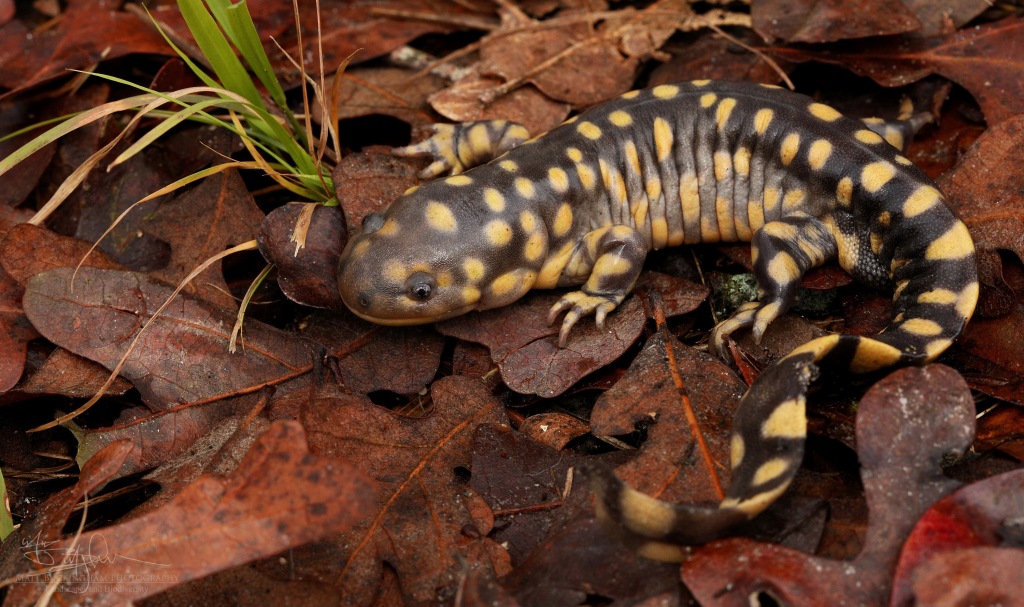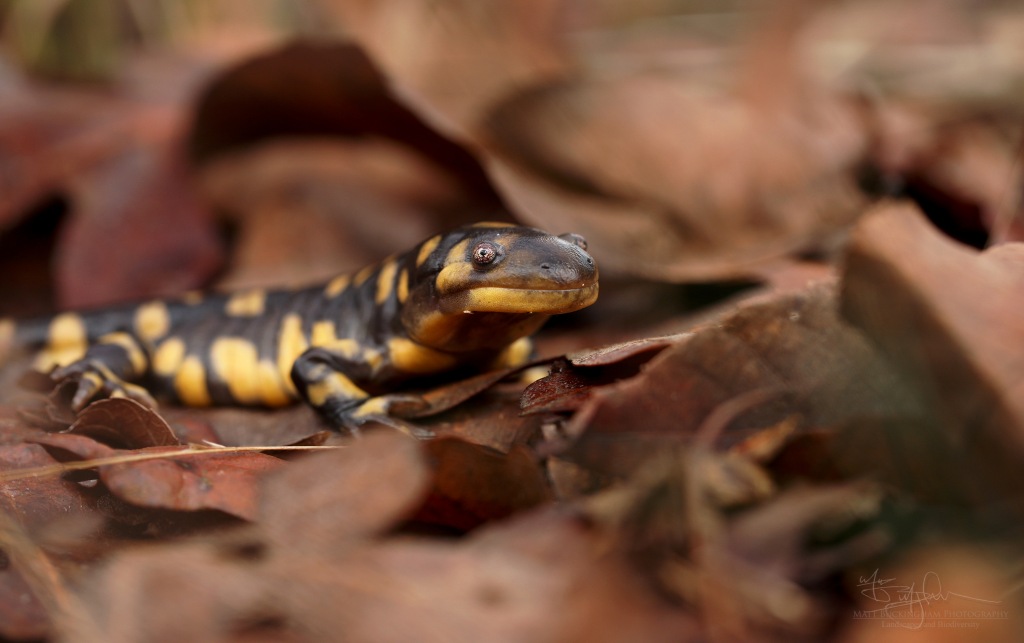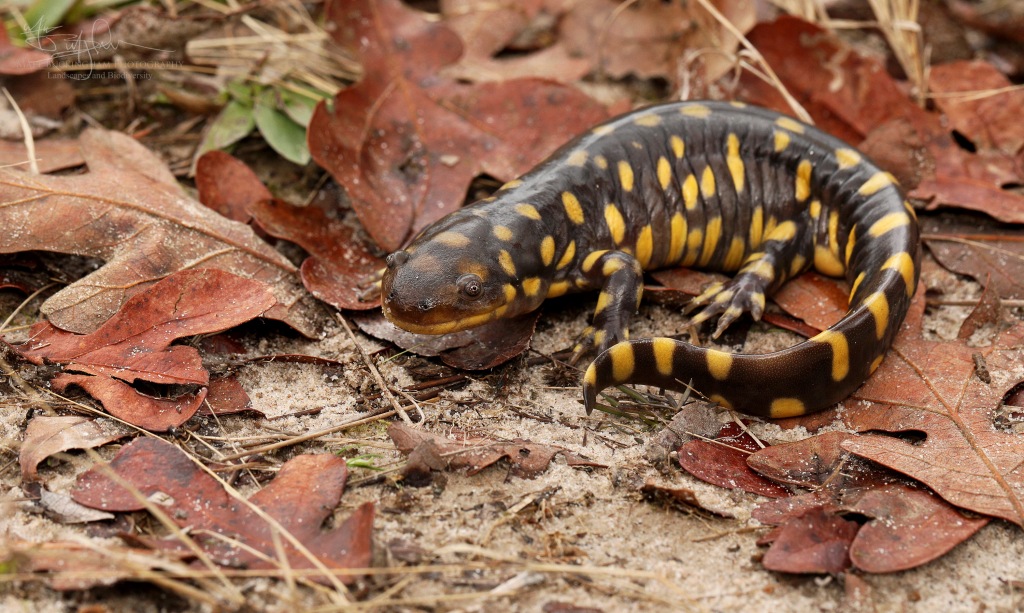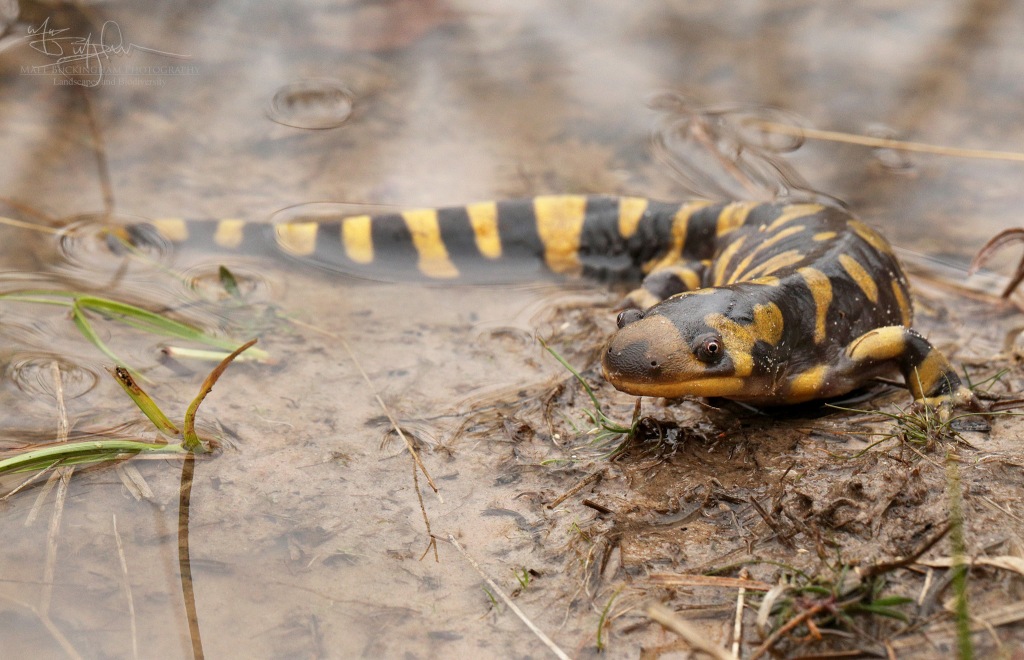You might say I owe a lot to the tiger salamander. One of my earliest memories is turning over a board and finding several of these impressive amphibians at a park near my childhood home in the suburbs north of Chicago. My parents let me take a few home and we kept them in an aquarium for a few years. They were quite personable, for amphibians, and I remember feeding them bits of hamburger meat from toothpicks. This experience was one of the catalysts that sparked a lifelong passion for the natural world. There was just something about those tiger salamanders. I would later come to appreciate all salamanders, but those of the genus Ambystoma, and A. tigrinum in particular would always hold a special place in my heart.
When I was 13 we moved to the suburbs of Houston. In southeast Texas I found a herpetological Eden. There was an abundance and diversity of amphibians and reptiles that was unlike anything I’d previously encountered. But none of these new species inspired me to the degree that my pet tiger salamanders had, and I hoped I might find some nearby. After all, most every map depicting the range of the eastern tiger salamander showed it occurring in or at least near the Houston area. Many years later, after research, conversations, and personal observations I would come to realize that if I wanted to see one, I would have to travel much farther afield.
On New Years Day, 2021, Caro and I joined our good friend John Williams to see if we could find something that very few have encountered, let alone photographed: an adult eastern tiger salamander (Ambystoma tigrinum) in Texas. Our experience that day would rekindle a passion for this amphibian enigma, and spark a fact finding mission, the early stages of which I will present in this narrative.
We set out early to meet John at a site in the Post Oak Savanna where we had previously found larval and juvenile A. tigrinum. The day was cold, gray, and wet. A cold front had just passed through the region, dropping nearly three inches of rain on New Year’s Eve. The conditions seemed perfect for an Ambystoma migration, but there is little information on A. tigrinum breeding habits in Texas, so we could only hope that our timing was right.
To reach the breeding ponds we would have to hike a mile or so through remnant post oak savanna. At spots we noted sand blowouts nearly void of woody vegetation. Habitat like this is important for a variety of rare, range-restricted plant and animal species, and few high quality examples remain. The ponds themselves occurred in clay-bottomed swales where water from rainfall and percolation from adjacent deep sands collected. These ponds had been artificially enhanced – deepened, presumably to provide water for wildlife on a more permanent basis. They remained fish free, however, and as a result the tiger salamanders and other amphibians have been able to persist here.
It was still in the 40s (Fahrenheit) when we reached the pond. John had the good sense to bring a pair of waders to stay warm and dry in the pond. I wasn’t as prepared, and as we stretched out the sein, I mentally prepared myself to enter the frigid water. And it was cold, at least at first. My numb, tingling legs soon went to the back of my mind, however, as we pulled the sein from the water after our first pass and saw that a huge black and yellow amphibian had come with it.

It was a big adult male eastern tiger salamander! And it was one of the most beautiful salamanders I had ever seen. It immediately struck me as an eastern, but with tigers, there is always a hint of doubt in the back of my mind. There is another salamander, the barred tiger salamander (Ambystoma mavortium) that occurs sporadically in the semi-arid regions of the western half of the state. A. mavortium was long considered one of several subspecies of A. tigrinum. At that point, A. tigrinum was the most widespread amphibian in North America, occurring from the east coast to Arizona north to Washington and southern Canada. Within this range they inhabit a wide range of habitats, from forest pools to desert cienegas to subalpine lakes. In portions of their range, like northern Illinois, where I first became acquainted with them, they can even inhabit fishless ponds in urbanized areas, pastures, and agricultural fields.
Within this range they exhibit a broad range of behavioral ecologies and natural histories. In the west populations often contain both terrestrial and neotenic adults. Neoteny is the retention of various juvenile characteristics into adulthood. In this case, some adult salamander remain aquatic, retaining their gills, tail fins, and other characteristics that help them lead a life in the water. Other adults lose those characteristic and morph into gill-less adults that spend the majority of their lives on land in subterranean burrows. Neoteny has only been observed in one population of Michigan eastern tiger salamanders.
Morphologically, however, there is little to no difference between tiger salamanders throughout their range. A mavortium was split from A. tigrinum based primarily on adult coloration, egg mass characteristics, and the occurrence of neoteny. In the resulting split, eastern tiger salamanders remained A. tigrinum with no subspecies, while all other previously recognized subspecies were absorbed into A. mavortium. A. tigrinum is recognized as having more numerous, smaller spots and blotches on the body that range from creamy yellow to copper to olive brown. A. tigrinum also lays eggs in loose gelatinous masses, and only very rarely exhibits neoteny. A. mavortium mavortium (the barred tiger salamander) is recognized as having fewer larger spots, blotches, and bars that range from lemon yellow to olive. Barred tigers generally lay their eggs in lines or strips along vegetation, and neotenic populations are numerous. If you fine explanation for differences in the appearance of adults to be rather vague, you’re not alone. Tiger salamanders are extremely variable, and there are considerable differences in the patterns of individuals between and even within populations. The papers I’ve seen advocating for this split leave a lot to be desired, in my opinion, which begs the question, should they really be considered separate species? I could talk at length about the philosophy of species delineation, which isn’t the intended purpose of this blog, but to keep it short I’ll say that there is considerable disagreement and a wealthy of opinions in the field of taxonomy as to what should constitute a species. The concept of a “species” is far from black and white, and as a result we see a constant flow of changing taxonomies, with species being split, lumped back together, and so on and so forth.
The salamander that we had caught definitely fit the bill for A. tigrinum. Numerous orange-yellow spots scattered about its head, back, sides, and tail. It was easily identifiable as a male by it’s swollen cloaca and flattened, rudder like tail. These are changes that occur in males during the breeding season. The tiger salamander is one of the largest terrestrial salamanders in the world, and seeing one in person is an unforgettable experience.

It was quite clear to me that John and I had seined up an eastern tiger, but the plot thickens. Larval tiger salamanders and neotenic adults have long been used as fishing bait. They are famous for their ability to snag large bass, and can frequently been found in bait shops. These bait salamanders are most often A. mavortium as they are more readily obtained from breeding ponds year round. A. tigrinum and A. mavortium also differ in their breeding ecology, for the most part. A. tigrinum are animals eastern North America, where the winters are typically wet, and seasonal pools fill during the winter and early spring when rainfall is more abundant and water requirements of plants is lower due to winter dormancy. For this reason they breed in the winter and early spring in more northern latitudes and late fall and early winter in the more southerly portions of their range.
Throughout much of their range, A. mavortium occur in habitats that are influenced by summer monsoonal range and experience dry winters. As a result, many of these populations breed in the summer months. Once again, however, there is overlap, and many populations of A. mavortium breed in the winter months similar to A. tigrinum.
But I digress. Salamander larvae used as fish bait have been introduced to many areas where they do not natural occurred, or distributed to new areas within their range, changing the genetics of local populations. This has become a major problem in the western U.S., where non-native barred salamanders have become established in parts of California and Arizona. Here they interbreed with the federally endangered California tiger salamander (Ambystoma californiense) and Sonoran tiger salamander (Ambystoma mavortium stebbinsi), and threaten native populations here by diluting the gene pool.
This same phenomenon has been purported to occur in East Texas as well, however I am skeptical that it has actually occurred, particularly to a sufficient degree to threaten native populations here. The only evidence that I have been able to find that this could occur is the presence of A. mavortium larvae or neotenic adults at bait shops in the region. I have heard from several individuals that they have found, purchased, and used these as bass bait in popular East Texas fishing spots. I have yet to find evidence, however, that these larvae have been introduced and formed naturalized populations. I think it is unlikely that this is occurring for the following reasons:
- Tiger salamanders in East Texas are apparently quite rare and declining. With few known populations, it is unlikely that numerous introduced populations have become established.
- The appearance of animals from East Texas and adjacent western Louisiana is quite similar. If introduced populations were prevalent here, I would expect there to be significant variation in the appearance of animals from the region. Granted, many of these animals do seem to show some similarity to the coloration of barred tiger salamanders, however the same is true of eastern tiger salamanders in other parts of their range. In east Texas, this may also be influenced by the proximity to the contact zone with naturally occurring barred tiger salamander populations.
- Known populations by and large do not occur near fishing hotspots, despite the presence of suitable habitat. I would expect that populations established from introduced fish bait would be more common in those areas where fishing and bait shops are more prevalent.
- Tiger salamanders in east Texas exhibit a very specific distributional pattern and habitat preference, which I will describe further below.
The range of the eastern tiger salamander, whether relating to the subspecies or the full subspecies, generally is shown as reaching its southwestern limit in eastern Texas. Being the salamander fanatic that I am, I long wanted to find them, but soon came to realize that it would be no easy task. Through years of research and personal experience, a pattern of habitat preference began to develop. Virtually all of the records I could locate of A. tigrinum in East Texas are from three bands of Eocene sand deposits: The Queen City, Sparta, and Carrizo sands of the Claibourne Formation. Here they primarily breed in clay-bottomed depressions, and in some cases man-made ponds, in sandy uplands that are or were historically post oak savanna.
After a prolonged bout of exciting shouting, high fives, and hugs, John and I made another pass with the sein, which yielded another strikingly patterned male tiger salamander. It too was characterized by numerous small spots. It was shaping up to be one of my most memorable salamander hunting experiences to date.



Our next pass yielded a huge gravid female. This individual, with the exception of having slightly brighter colors, was nearly identical to the salamanders I found under that board in northern Illinois all those years ago. She was the last salamander we caught in that first pond, but another pass yielded a large gelatinous egg mass – further supporting our claim that these were eastern tiger salamanders, and not A. mavortium or some mix of the two. It should also be stated that neoteny has not been observed in this population or any other population of A. tigrinum in East Texas.

When photographing salamanders, I like to take images from several images. A standard field guide shot of a posed salamander in interesting substrate is always nice, but in recent years I’ve really come to like photographing them from above. Their patterns and colors are most striking on their dorsum, and photographing them this way helps place them in their environment. It also helped to highlight the plumpness of this gravid female.

After photographing our salamander finds, we moved on to another nearby pond. Here we found a single female. Of all of the salamanders we found that day, she bore the closest resemblance to A. mavortium. Her spots and blotches were larger than the others, and some were bleeding into bars. In my opinion, however, she was still well within the realm of A. tigrinum patterning and coloration, and as I’ve noted above there is considerable overlap.



Satisfied with a highly productive outing, we packed up after four salamanders, dozens of photographs, and a couple of hours in good company. The very first day of 2021 will be a hard one to top! The experience served to enhance and deepen my appreciation for these animals and opened up a wormhole about their genetics, regional relationships, patterns, habitat preference, and much more. I think that finding answers to these questions is important, as by all accounts and appearances, the eastern tiger salamander in Texas is rare and declining, and most certainly worthy of conservation efforts.

Because writers don’t hear it enough: you are admired and appreciated and your writing is a legacy…
>
LikeLiked by 1 person
Thanks so much for the kind words!
LikeLike
Great blog Matt!. Reminds me of my early days also when I caught and kept a tiger salamander in OK.
LikeLiked by 1 person
They’re incredible creatures!
LikeLike
Fantastic write up Matt. Between this and our time in the field – I’m just so eager to learn and experience more about this special group of animals. Thank you for sharing so freely.
LikeLiked by 1 person
Thanks for the comment Romey! It was great getting into the field with y’all and I hope it’s the first of many outings to come. Looking forward to your re-vamped blog!
LikeLike
Love these little critters. I have seen them only a few times in my life.
LikeLiked by 1 person
Seeing one is always such a memorable experience!
LikeLike
I rarely see salamanders, and these Texas tigers are unbelievably attractive. What a day for you! I smiled at your brief discussion of species. When I first began trying to sort out scientific names and taxonomy, ‘lumpers and splitters’ was one of the first distinctions I learned.
I always discover a new word or two from your posts, too. This time, it’s ‘neoteny.’ Thanks for all the work you put into these posts; education and beauty together is quite a treat.
LikeLiked by 1 person
Thanks! Salamanders are such interesting, beautiful creatures!
LikeLiked by 1 person
I enjoyed your article on on Texas. Neotenic tigers have been found in the Davis Mountain Preserve
tigers
LikeLiked by 1 person
Thanks Gary! I remember you telling me about those neotenic tigers on the preserve. I hope to see them some day!
LikeLike